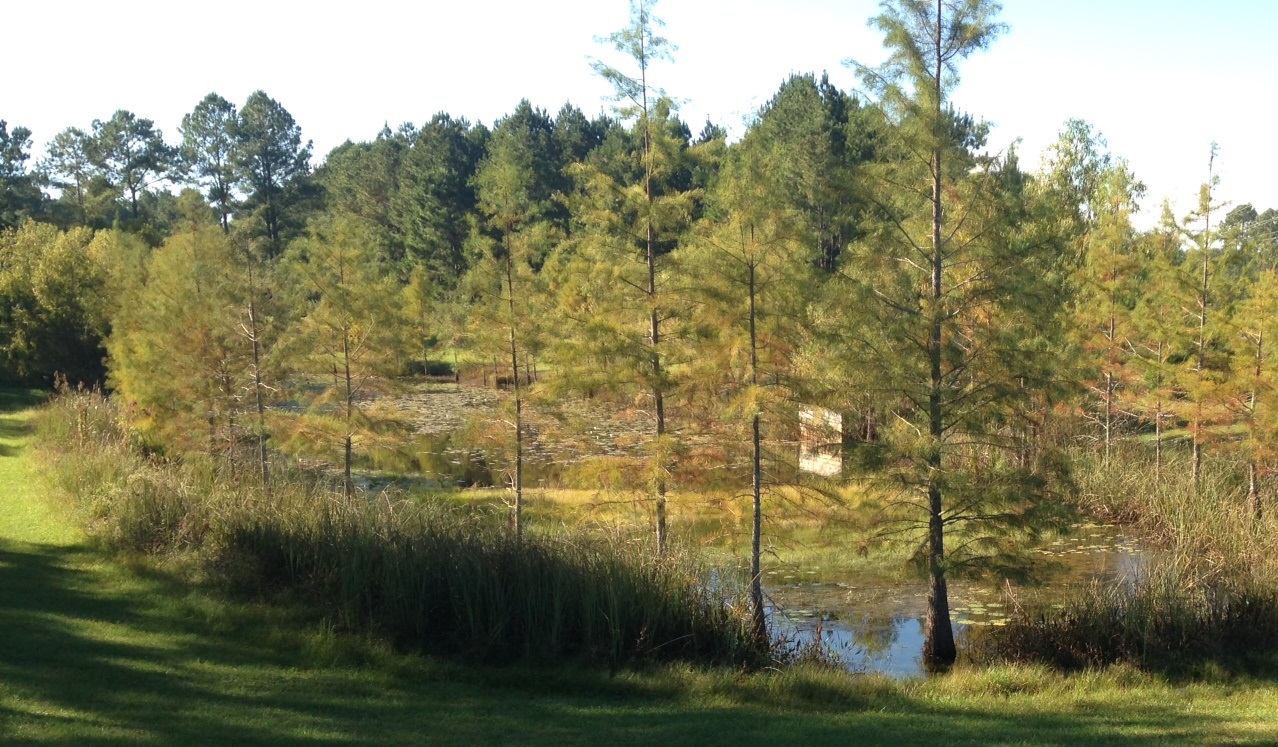
by Carrie Stevenson | Nov 4, 2014
I recently met with a group of community volunteers who are interested in providing more butterfly habitat in our public areas. Monarchs migrating to Mexico this time of year use northwest Florida as a stopover and feeding site, but if host plants are unavailable they cannot sustain a healthy population. In addition, Gulf fritillaries, buckeyes, and swallowtails are spending time in local butterfly gardens, feeding on passion vine, butterfly bush, milkweed, and more.
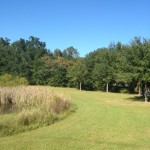
The grassy area between this stormwater pond and woods is an ideal location for a butterfly garden. Willows growing along the edge attract butterflies already. Photo credit: Carrie Stevenson
The volunteers and several county staff visited three publicly-managed stormwater ponds, which are an ideal setting for what some proponents term “Butterflyscaping.” The open space, water source, and diversity of plants along the edge of the ponds lend themselves well to wildlife habitat.
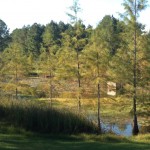
The permanently wet detention pond lined with cypress trees and sawgrass also provides habitat for fish, birds, and reptiles. Photo credit: Carrie Stevenson
When considering adding vegetation to a neighborhood common area, there are several things to consider. First is maintenance. If there’s an annual contract with a landscaping company to mow or maintain an area, you’ll want to have a discussion about excluding the new planting area from mowing to establish new vegetation. You’ll also want to look at the soil and amount of sunlight to determine the best plant choices for the area.
A variety of groundcovers, flowering plants, shrubs and small trees will typically provide food for both caterpillars and adult butterflies. Once established, these new landscape additions will not only provide habitat and color, but may end up reducing maintenance costs as well.
For more information, the UF publication “Community Butterflyscaping” is an excellent resource for landscape design, plant choices, and practical steps toward getting started with a neighborhood or schoolyard project.
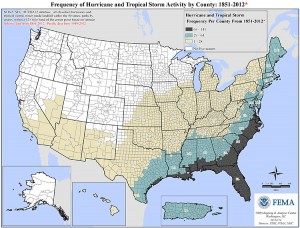
by Carrie Stevenson | Jun 23, 2014
Since the heavy flooding in late April of this year, many property owners have expressed concern to me and their local government officials about their neighborhood’s vulnerability to flooding. Homes and landscapes are most people’s largest investment, and the damage caused by a major storm can be financially and emotionally devastating.

This map shows Florida’s extreme vulnerability to hurricanes and tropical storms, compared with the rest of the country. Graphics courtesy FEMA
To say that Florida is prone to flood is an understatement, at best. Between 1851 and 2012, every county in our state endured between 65 and 141 tropical storms and hurricanes. Many counties average one named storm every 1.1 years. While other states have coastal regions vulnerable to hurricanes, the entire state of Florida lies within FEMA’s highest designation of storm frequency. With hurricane season just beginning and record-breaking flood events in April, it is wise to consider flood insurance. Regular homeowners’ insurance policies do not cover damage related to flooding. Many homeowners go without flood insurance because their home is “high and dry” or “not in a flood zone.” It can be argued, however, that as a Floridian, particularly one in a region of the state with the highest annual average rainfall, you’re in a flood zone—it’s just a matter of whether you’re high or low risk. And, as we’ve seen recently, even those who thought they were low risk could be vulnerable.
Flood insurance is often very inexpensive for those outside of officially designated Special Flood Hazard Areas (think waterfront homes, low-lying property, creek floodplains, and barrier islands). Rates can be as low as $130/year for basic coverage in a low-risk area. It’s simple to get a ballpark figure for potential flood insurance costs by entering your address into a one-step “risk profile” online. According to the National Flood Insurance Program’s (NFIP) website, a quarter of NFIP flood insurance claims and third of Federal Disaster Assistance each year goes to residents outside a mapped high-risk flood zone . When the expenses related to flooding, including removal of flooring, walls, furniture, and damage to plumbing and wiring, are taken into consideration, flood insurance can be a smart investment.

Intense flooding can strike in unexpected locations during heavy rainstorms and tropical storms. This Pensacola street had never experienced serious flood damage prior to April 2014, so most residents did not have flood insurance. Photo credit: Carrie Stevenson
Timing is important, too, because a 30-day waiting period is often required before flood insurance coverage kicks in. If you are also looking at additional windstorm insurance, be aware that policies will not be sold if a storm is in the Gulf. It is important to act sooner than later, but if you start now you can have flood and windstorm coverage in place before August and September. Our most severe storms historically occur during these months, after the Gulf has had all summer to warm up.
To purchase flood insurance, contact your local agent, find an agent online at www.floodsmart.gov, or call 1-888-379-9531. Be sure to ask exactly what is covered and under what circumstances, as there are many particularities to flood insurance. For up-to-date information on recent changes to the NFIP, please visit Coastal Planning Specialist Thomas Ruppert’s webpage.
Disclosure: The University of Florida/IFAS Extension program cannot make specific recommendations on insurance agents or providers. Please make the best decision for your home and family to prepare for storms and flooding.
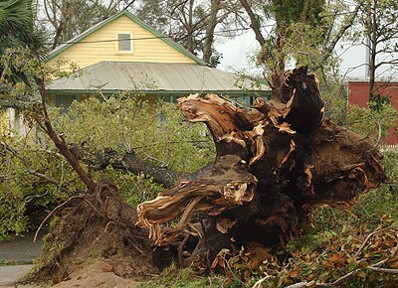
by Carrie Stevenson | Oct 7, 2013
After severe weather of any kind, homeowners must often spend a considerable amount of time dealing with impacts to their landscapes. Below are a few lessons we have learned from hurricanes and tropical storms in the past. Many thanks to fellow agent Beth Bolles for her contributions to this article.
Dealing with Toppled Trees
It may be difficult to turn an uprooted favorite tree into firewood, but this is probably the best choice. A small or young tree may be replanted successfully if done immediately. These trees will require bracing for up to two years until the root systems regrow and are able to support themselves. If the roots have been exposed for an extended period of time, don’t try and save the tree. Exposed roots should be covered with soil or moist burlap for protection from drying out. Large or older trees will typically not survive this ordeal even with the best of care. Because the root system is compromised, attempting to keep the tree may create a hazard down the road with the next storm.
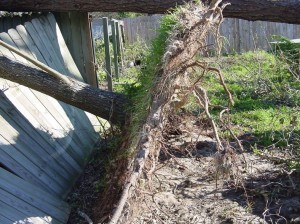
If a tree is completely uprooted, its odds of recovery are severely limited and it is best to remove the tree. Photo courtesy Beth Bolles, UF IFAS Extension
When removing fallen trees, think ahead about whether you plan to remove stumps. It’s a lot easier to pull instead of dig stumps out of the ground, so leave a four-foot stump to make your life easier. Be careful using power equipment like chain saws. It may be better to hire a professional to deal with removing large trees, especially around power lines.
Exposed Roots or Leaning Trees
Any exposed roots should be covered immediately. Cover roots with nearby soil at the same level roots were originally growing. Do not bank the soil higher because this will cut off oxygen supplies to roots in an already oxygen deprived, saturated soil.
If small trees are leaning and need straightening, they can be staked and treated like a newly planted tree. Larger trees with trunks greater than six inches in diameter can be saved but should be removed if they are a hazard to structures, power lines, or roadways. Reset the trees with stakes or guy wires for support. Trees with trunks measuring less than two inches in diameter can be supported with two or three forty-eight inch, two inch by two inch wood stakes placed one foot outside of the root ball inserted eighteen inches into the ground. Larger trees should be anchored with three or four guy wires or cables. Cover guy wires that are in contact with the trunk with rubber hoses to prevent damage.
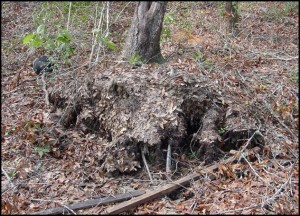
A leaning, partially uprooted tree may recover if it is righted and its roots are covered back with soil. Photo courtesty Beth Bolles, UF IFAS Extension
Replace the soil around the area and firm to assure there are no air pockets around the roots. Make sure the top root coming off the trunk is level with the existing soil. If many trees were swaying back and forth during the wind, there may be air pockets underneath the trees. If this is obvious, add soil and water to eliminate any air pockets. If root damage is obvious, do not fertilize at this time because salts in the fertilizer may damage new feeder roots.
Broken Branches
Broken branches should be removed from trees and shrubs as soon as possible to prevent tearing into trunk wood. Make clean cuts just outside of the branch collar to avoid damaging the trunk. If these are large branches, make three separate cuts to prevent tearing. Make the first cut on the underside of the branch about fifteen inches from the trunk and one-third through the branch. The second cut is made from the top, a few inches out from the first cut. This cut should remove the weight of the branch so the next one will not rip the trunk. The remaining stub can be held while the last cut is made. Make the last cut just outside the branch bark ridge and end outside the trunk collar (swollen area on lower side of branch). This is not a flush cut with the trunk and should leave a small protrusion on the trunk. Do not use wound dressing on the cut surface, as this practice is no longer recommended.
If trees lost all of their branches, it is advisable to remove the tree. The natural shape is gone and trees like pines will typically not recover. Some trees may lose the majority of their leaves, but these will flush back out so they should be okay.
Repairing Lawns
Keep a close eye on lawns for disease problems due to all the rain. Brown patch and take-all root rot would be the major concerns. Rake and remove all debris to give lawns a chance to dry out. If lawn areas are damaged, now is the time to replace with plugs or sod so they can establish before winter. Sod webworms are bad now so don’t mistake this damage for diseases. If adult moths are obvious and grass blades are closely cropped, this is due to caterpillar damage…not disease.
Watering
Most soils are saturated and irrigation systems should be in the off-mode. If there is standing water around trees or in other low areas, use a hose to siphon water to a retention pond or a better-drained area. Once soils dry out and the sun comes out, keep a close eye on plants as they may require more frequent irrigation because of root damage. Coastal areas flooded with saltwater may experience damage from extended exposure to high salinity; it is recommended to run a sprinkler system to flush out a lawn after the water retreats.
If you have questions, contact your local UF IFAS Extension Office!

by Carrie Stevenson | Jul 7, 2013
Floridians use more water than any other state for irrigation, and a typical home sprinkler system can account for half of the cost and water use in a household during the summer.
One of the most convenient and efficient ways to conserve water is to install a rain barrel. Modern rain barrels involve ancient technology that relies simply on gravity, allowing stormwater to run from a rooftop into a gutter. The gutter funnels water into a plastic food-grade barrel or other container fitted with screen to keep out debris and insects. Most rain barrels also have an overflow device near the top (for heavy storms that might fill the barrel) and a spigot at the bottom for filling a watering can or attaching a hose. Keep in mind the barrels do not have a lot of pressure and cannot irrigate an entire lawn, but are ideal for vegetable gardens and container plants. Rain barrels vary widely in design, but they can be painted to add a decorative touch, or easily screened behind a shrub.
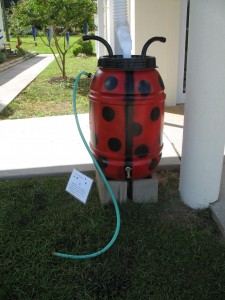
Building a rain barrel is a fun summer project for the whole family!
In addition to conserving water, rain barrels can be an effective means of reducing stormwater pollution. During a typical 1” rainstorm, an average home’s roof can yield 600 gallons of rainwater runoff that would normally flow downstream, picking up oils, greases, bacteria, trash, and pesticides along the way that end up in our water bodies. These pollutants eventually flow downstream to our creeks, bayous, and bays, contributing to non-point source pollution. Rain barrels interrupt that process by collecting stormwater runoff before it has a chance to pick up pollutants.
If you are interested in learning more about rain barrels or how to build your own, contact your local County Extension Office. Escambia County Extension will be hosting two rain barrel workshops this summer, the first on Friday, July 12 and the second on Saturday, August 3. There is a $42 charge for those wishing to build their own rain barrel after the workshop—all supplies and tools will be provided. To register for the full workshop, go online to the event registration website.
It is free to attend and hear the talk without building a barrel, but please reserve a spot by using the contact information below.











